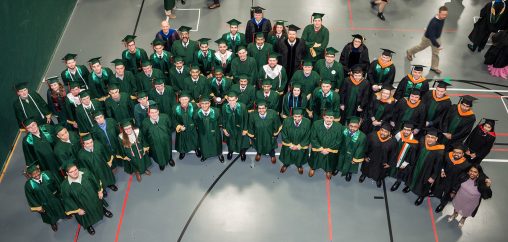
Enrollment in the Department of Mechanical and Materials Engineering has surged thanks to Wright State’s proximity to Wright-Patterson Air Force Base, quality of teaching, strong internship programs and flexible courses. (Photo by Chris Snyder)
Fall commencement at Wright State University capped a year that saw a record number of students graduate from the Department of Mechanical and Materials Engineering in the College of Engineering and Computer Science.
The 237 graduates, including 20 from the Lake Campus, were the most in the 30-year history of the Mechanical and Materials Engineering programs and included the first aerospace engineering graduate.
Joseph Slater, department chair, said the number of students majoring in disciplines offered under the department umbrella has been increasing for a number of years. He credits the popularity and diversity of the majors, the university’s proximity to Wright-Patterson Air Force Base, the high quality of and individualized nature of the teaching, the strong internship programs and the flexibility of the courses.
In 2017, 153 students graduated with bachelor’s degrees in mechanical engineering and 55 with master’s degrees. There were 10 bachelor’s degrees and seven master’s degrees in materials science engineering, respectively; 10 master’s degrees in renewables and clean energy; one degree in aerospace engineering and one Ph.D. graduate. A majority of the students received their degrees during spring commencement, when 129 graduated.
The department was formed in 1986 and as recently as five years ago only had about 70 percent as many students as it does today.
Slater said one reason for the department’s surging popularity is the diversity of its programs.
“We hit some of the exciting and hot topics,” he said. “We just started aerospace engineering a couple of years ago. We have manufacturing classes in additive manufacturing, powder processing, metal forming. And we have some of the world’s best scientists in nano-manufacturing when you get to the graduate level.”
The curriculum has been modernized and shaped by students’ internship experiences.
“This sets us aside from a lot of other institutions because our students have the opportunity to take classes that are close to what they will do with that internship,” Slater said.
The department also works to accommodate students’ needs and schedules. Many students have full-time jobs and need flexibility in their courses and internships.
Slater said the department’s award-winning faculty put the students first and focus on practical applied learning without taking away from the more rigorous theoretical learning.
“While we have a large enrollment, our students still get individualized, small group, capstone-designed projects,” he said. “Each one of them gets to work in a small group of three to five students with an individual faculty member and get that individualized attention.”
Most of the department’s faculty members have connections to the Air Force Research Laboratory at Wright-Patterson.
“The advantage of being in Dayton, Ohio, means we’ve got the world’s largest Air Force research facility next door,” said Slater. “And students are working there in between their classes. That separates us from other institutions.”
The region is also a hotbed also for manufacturing — especially in the automotive areas — and offers many employment opportunities. Graduates have gotten jobs at DMAX, General Electric, Honda, Emerson Climate Control and other manufacturers.
Slater said the department has had a large number of international students in the past few years, but that is expected to decrease. However, he said local enrollments are helping make up for that. Full-time equivalency enrollment last fall, for example, was the highest in the department’s history.
Slater said the future looks bright for the department.
“We are going to thrive; we are going to excel,” he said. “There are an awful lot of challenges that higher education faces right now. We can’t control the environment that we’re in, but we can control our reaction to that environment. We know what we need to do, and we’re doing it.”

 Wright State’s nursing program celebrates 50th anniversary
Wright State’s nursing program celebrates 50th anniversary  Wright State celebrates Student Success Champions
Wright State celebrates Student Success Champions  Wright State gold team captures 2024 Horizon League team title, Flynn individual champion
Wright State gold team captures 2024 Horizon League team title, Flynn individual champion  118 medical students to graduate from Wright State’s Boonshoft School of Medicine April 28
118 medical students to graduate from Wright State’s Boonshoft School of Medicine April 28  Wright State University continues to demonstrate its financial strength with another credit rating upgrade from Moody’s
Wright State University continues to demonstrate its financial strength with another credit rating upgrade from Moody’s 